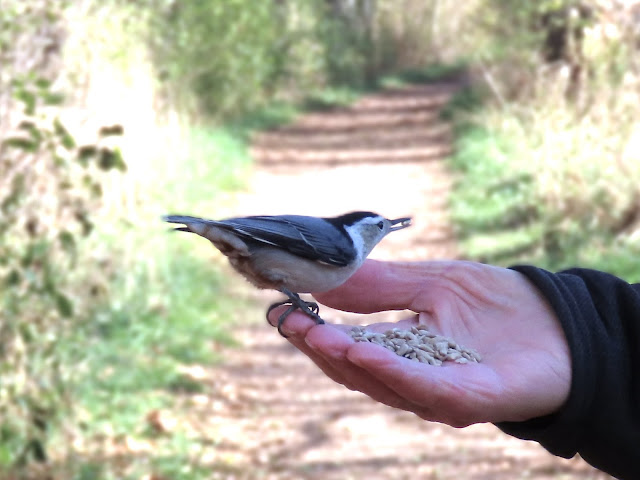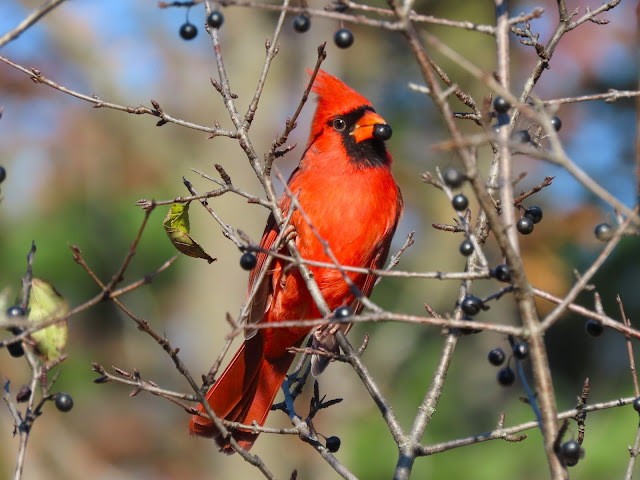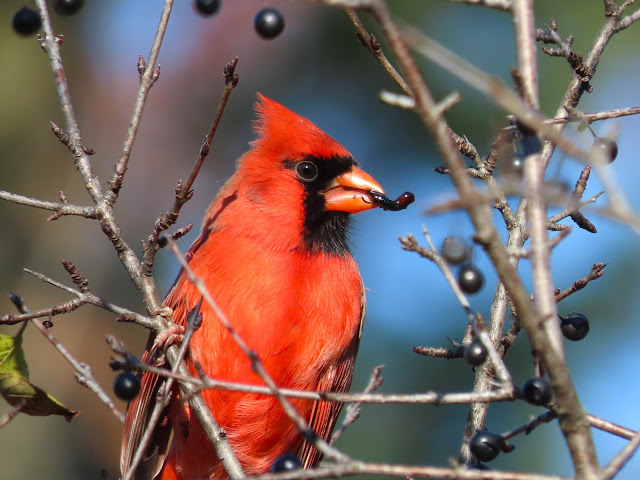As I look back over my files there is lots to catch up on, incredibly going all the way back to November.
So, here goes!
03 November, 2023
University of Waterloo Agricultural Land and Columbia Lake
The field had been freshly ploughed and a large congregation of crows (I could say a Murder of Crows, but it seems so artificial and no one actually uses this archaic term) was plundering the worms and arthropods brought to the surface by the disturbance of the soil.
Strangely, (at least it seemed so to me), no gulls had joined the fray, but on nearby Columbia Lake, American Herring Gulls (Larus smithsonianus) and a Ring-billed Gull (Larus delawarensis) were swimming together.
12 November, 2023
Three Bridges Road and The Mill Race, St. Jacobs, ON
There was an engaging display of equine affection at the Mennonite meeting house on Three Bridges Road, as the horses waited patiently for the service to end, when they could head for home.
It is a rare occasion when a Downy Woodpecker (Dryobates pubescens) will feed from the hand, so I was pleasantly surprised when this bold male decided that the seeds were not for chickadees alone.
Having cached its seed in a secure location underneath the bark of a tree it was content to perch for a moment or two, declining the opportunity of a repeat performance.
Very rarely, a Blue Jay (Cyanocitta cristata) will alight on a hand too, although it has been a long time since I enjoyed the pleasure.
If I were ever asked to assign a new name to the Mill Race Trail, I would have no hesitation in selecting Chickadee Trail. Black-capped Chickadee (Poecile atricapillus) is by a considerable margin the most frequently seen bird, and the most endearing too.
A flotilla of Canada Geese (Branta canadensis) rivals children skating on a frozen pond as an enduring symbol of Canada.
13 November, 2023
Bannister Lake and F.W.R. Dickson Wilderness Area, New Dumfries, ON
A quick stop at Bannister Lake yielded about thirty Sandhill Cranes (Antigone canadensis) scattered around the distant shore.
It is a cause for considerable joy each time Trumpeter Swans (Cygnus buccinator) are sighted away from the main flock in Burlington, indicating that the long struggle to reintroduce this extirpated species to Ontario has succeeded. Miriam and I know of a location in Waterloo Region where they have bred successfully for at least two years.
At nearby F.W.R. Dickson Wilderness Area the marquis billing still goes to Tufted Titmouse (Baeolophus bicolor), a species I am convinced is undergoing range expansion and will, within a few years, become quite common.
In the meantime, legions of photographers descend en masse, bringing food and props to impart a natural feel to their shots.
Not surprisingly, other birds are quick to take advantage of anthropogenic largesse.
Dark-eyed Junco (Junco hyemalis)
No one is surprised that Blue Jays muscle other birds off the food to make sure that they claim their share.
American Goldfinch (Spinus tristis) is not clad in robes of gold at this time of year, yet is nevertheless extremely attractive.
Northern Cardinals (Cardinalis cardinalis) gathered seed from the fence rail, but were equally content to gorge on berries.
Red-bellied Woodpeckers (Melanerpes carolinus) were back and forth, yet never in a position for that perfect shot.
A very hardy Asian Lady Beetle (Harmonia axyridis) trundled along searching for a safe spot to spend the winter.










































Hari OM
ReplyDeleteWowsers, that sure was some catchup!!! I like the new header, too... YAM xx
...I've NEVER seen so many crows in one spot!
ReplyDeleteAbout ten thousand roost in Waterloo Park every night in the winter. They come into the city where it is warmer than the surrounding countryside. Howard Nelson, an American poet, has written a wonderful poem about urban crows.
DeleteIn the winter we have large crowds of crows in the neighborhood, sometimes the trees are compeletely covered with them. It's a sight to behold - I enjoy it as well as the really loud noise they are capable of. Oh my, those Sandhill Cranes, how beautiful! So far I have seen them only once or twice, in Yellowstone when we were actually looking for moose in the very early morning hours. We were so lucky that morning and found both in abundance. I assume these are Miriam's photos - they are exquisite. Please tell her. And I love the new blog banner of you and Miriam - lovely people. Enjoy the rest of the week, David. Hugs - Carola
ReplyDeleteFirst of all, you and Miriam look great in that new header. That tree has a really cool burl too. It's huge. And you're lucky to have sandhill cranes. We don't get them here, at least as far as I've seen, and they are pretty interesting birds. A few times on my travels toNew Mexico I saw and even more so heard them migrating north. But even though we see them all the time, you can't go wrong with chickadees, nuthatches, blue jays and woodpeckers. I still want to know who named the red bellied woodpecker and where the red belly comes from. hugs-Erika
ReplyDeleteThey do have a red smudge on the lower part of the belly, but it is difficult to see.
DeleteAlways a joy!
ReplyDeleteI do love those Tufted Titmouse. So cute! :)
Ohhhhhh! what a spectacular frontispiece, you look great, Miriam & David! shocking beautiful!
ReplyDeleteIn addition to the diversity of birds, i also like to observe the small moments of wildlife that often go unnoticed. Birds in general, a flotilla of Canadian geese, the cardinals, the lady beetle and horses generate a strong emotional connection for me. It is very pleasant to observe these beautiful moments captured by cameras forever.
Saludos, chicos queridos. Muchos besos y abrazos desde Buenos Aires!
Dear Carolina: I have been called many things in my life, shockingly beautiful not being one of them. I shall bask in the glory of it all day!
Deletejajaja lol :D
DeleteI just wish expressed myself correctly. You guys look happy and splendid.
You express yourself wonderfully, Carolina. Your command of English is impressive. David xo
DeleteIt amazes me the different varieties of birds living just a couple of provinces over. Chickadees are ubiquitous here, in fact our city has named it our official bird. We see Blue Jays, juncos, nuthatches and finch here too, but the tufted Titmouse is new to me (what a cutie), and I've yet to see a cardinal in person.
ReplyDeleteThanks for the update and sharing the photos!
wow feeding woodpecker from your hand...that's just amazing! The new header of Mirima and you looks splendid, David.
ReplyDeleteHow lovely to see all these photos. Many crows there. Gorgeous is that Cardinal, more orange than red I thought in that photo..take care.
ReplyDeleteSooooo many gems. I love the crows. While I am a collector of collective nouns a murder of crows is just plain wrong.
ReplyDeleteThe horses snuggled in together is charming, as are all of your other shots. Thank you, thank you, thank you.
We could probably agree on a deceit of politicians.
DeleteI stand back in awe as you manage to hand feed the local wildlife. You must have very steady hands.
ReplyDeleteAnd patience.
DeleteBeautiful series of photos David.
ReplyDeleteIt's really cool that this downy woodpecker comes to sit on your hands to eat.
The Blue Jay, the White-necked Nuthatch and the Tufted Tit are also great to see, I have never seen them before.
The American Tree Sparrow and Northern Cardinals are species that do not occur here.
I enjoyed the bird photos again.
Greetings Irma
lol, all those crows! It looks the same at my place. :) :) Lots and lots of them this time of the year.
ReplyDeleteInvest a little time and you can make friends with them, quite literally. Our crow “family” comes to visit every day for their morning snack.
DeleteNice catch up David, and nice new header! It's lovely to see all the different birds. Sitta carolinensis is very similar to our Sitta europaea. They are funny to watch.
ReplyDeleteThe Tufted Titmouse is very very cute!
Hugs and kisses, Marit
the chickadee and the horses are my favorites today, both tug at the heart strings. No wait! fav is the tufted titmouse. OOPS i like that cardinal smoking a pipe. and the jays are goregous. I guess i will have to say each and every bird is beautiful and precious and adorable. Well maybe not those words for the murder of crows. but they are handsome
ReplyDeleteAnd they are very smart too.
DeleteHaving a White-breasted Nuthatch in the hand would be an absolute delight for me, David, and having a Downy Woodpecker so close is beyond my wildest dreams. Such intimate moments with the ability to be so close to a wild creature are to be cherished. I have only ever seen wild birds feed from the hand in Scotland, and then it was Chaffinches (on Mull) and Coal Tits (at Loch Garten).
ReplyDeleteMy very best wishes to you both - - - Richard
It NEVER loses its appeal, Richard, and there is a sense of privilege and wonder every time. I led a an outing for seventeen fourth year undergraduate students last weekend and every one of them was overjoyed to hand feed a bird, taking off their gloves at minus 14 degrees to feel the bird on their hand. As always, the most sublime pleasures in life cost nothing.
DeleteHello,
ReplyDeleteWhat a great variety of birds. I would love to hand feed a woodpecker and nuthatch.
The Sandhill Cranes are a nice sight to see. Great collection of photos and outings.
Take care, have a great day!
The cranes and the swans are such a wonderful find. I would be thrilled with a cardinal. They are on the island but we haven’t seen any.
ReplyDeleteThat horse photo and hungry cardinal pix were my favorites. And you must be a woodpecker whisperer too! You sweet-talker, seed-sharer you! Wow -- that's very cool.
ReplyDeleteFlattery will get you everywhere!
DeleteSome of the birds that were regular at the feeder here last year are no shows this year: chickadee and tufted titmouse. Instead the goldfinches in their winter garb are coming in a flock. Not sure why that is. I see and hear the chickadees but they've given up on my feeder.
ReplyDeleteCrows are ubiquitous. I see crows in Hawaii. The swans you'll see in the man made pond at the Hyatt Regency in Maui, nowhere else in Hawaii. The birds in Hawaii are different than birds in Canada.
ReplyDeleteThe horses are very affectionate and Bannister Lake is very beautifully preserved.
ReplyDeleteA woodpecker feeding from your hand! I find it difficult enough to get a woodpecker to come round to my side of a tree or feeder! They are usually unbelievably wary in the UK in my experience.
ReplyDeleteYears ago I decided to try and learn as many bird collectives as I could. Why? Because I do crosswords!
A los campos recién arados, suelen acudir muchas aves. Al levantarse la tierra, quedan al descubierto los gusanillos e insectos que hay en ella.
ReplyDeleteUn abrazo.
Love the new photo of yyou and Miriam. As I started reading I thought it said, ' As I look back over my flies there is lots to catch up on,....then I read it a second time! Hugs, xxxxxxx
ReplyDeleteNo flies on you, Valerie!
DeleteI can tell by the birds that you are back home..Love your new header..
ReplyDeleteSweet photo of the horses.
I once had a Downy eat out of my hand when I was filling my feeders but of course wasn't able to take a picture. It looks like you were feeding them sunflower hearts..everybody's favorites..They have gotten so expensive....I dilute them with other seeds so instead of filling my feeders daily, they are only empty every three days or so...
Chickadees are my favorites.....We see a lot of Titmice..haha..Is that the plural for Titmouse?
The tree Sparrow and Song Sparrow are beautifully marked..I agree!!
Nice collection of photos!! Thanks for sharing...
You are very observant, they are indeed sunflower hearts. Nothing is too good for my avian friends! It’s interesting that you raise the issue of the plural of Titmouse; it is generally conceded that it is Titmouses, however cumbersome and counterintuitive that might seem.
DeleteSo many lovely birds, my favourite is the cute looking Tufted Titmouse.
ReplyDeleteAll the best Jan
PS I do like your new header photograph of you and Miriam.
Like the backyard feeders used to look. Well, excepting the water fowl. We did have crows.
ReplyDeleteImpressive variety of birds, David.
ReplyDeleteHow cool to handfeed a woodpecker!
Thanks for the "catch-up." You are right - there is a lot there! Love all the bird pictures, especially that merganser.
ReplyDeleteDear David,
ReplyDeletethat was a pleasant review - and what I loved most was to see the hand-feeding of the Downy Woodpecker! And seeing your many successful bird feeding photos, I think I should finally start bringing bird seed with me on my trips... (but I still think they'll only come if they already know you, right?) As for the Lady Beetle: I read that researchers at the British universities of Exeter and Cambridge found that the more intensely colored a ladybird is, the nastier it tastes. This is how the inect protects itself from its predators. The color of its wings reveals how poisonous it is. Birds understand the signal and are least likely to attack the most colorful species. I assume this also applies to Asian lady beetles, so this one is probably on the safe side.
All the best and have a good time, Traude
You are quite right, Traude. This is known as aposematism and I should have known that. Thanks for pointing it out. I will modify the text accordingly.
DeleteHi David.
ReplyDeleteWhat beautiful birds and ducks you show.
But the Woodpecker eating out of hand is really a Wah factor.
Greetings from Patricia.
ReplyDeleteWhat a delightful birding adventure! Northern Cardinals gorging on berries and the lady beetle are among my favorites.
Hello David,
ReplyDeleteGreat reports on your outings. All of the photos are wonderful, I always love the bird images. Cute ladybug photo. I would love to hand feed the birds, the birds here wait for me to leave, too timid to come close. Thank you for linking up and sharing your post. Take care, have a great weekend. PS, thank you for leaving me a comment.
A few years ago, Audubon published a great article on those obsolete (and often silly) group names for birds. You might enjoy:
ReplyDeletehttps://www.audubon.org/news/no-its-not-actually-murder-crows
About the bird species that are expanding their range: This is also happening in our area. Birders are excited and optimistic, but calmer minds fear that it’s another symptom of climate change.
Nice photos! best, mae at maefood.blogspot.com
Thanks, Mae. Very entertaining.
DeleteBeautiful all those different birds David.
ReplyDeleteSo beautifully colorful some of them are.
I enjoyed it, Greetings Tinie
Wow! That is a lot of crows. I enjoyed this post very much. Have a wonderful day.
ReplyDeleteEncantada como siempre de este hermoso recorrido. Un abrazo David.
ReplyDeleteHi David - equine love-in ... my SIL has a horse and a pony ... the horse had been taken to the field, the pony when ready was taken ... but 'where was my mate ... where oh where ... out of view of the pony at pony height ... not far away just over and down the hill'!! Once seen joy of joy - a canter to be together munching away. Lovely shots - thank you ... cheers Hilary
ReplyDeleteWow stunning the tame Downy Woodpecker !!
ReplyDelete